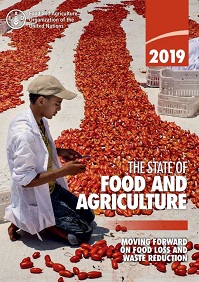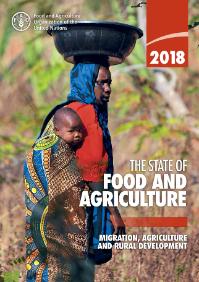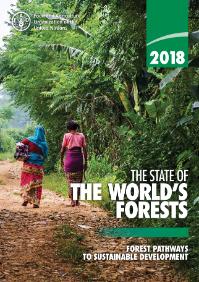Accelerate > Publications
Search this online library featuring the latest FAO publications, issue papers and briefs which offer up-to-date knowledge and innovative insights for SDG acceleration.
Highlights
New releases

Stepping up school-based food and nutrition education
2019
School-based food and nutrition education (SFNE) represents a crucial opportunity to reach children, families and the broader school community to foster lasting healthy food practices and capacities. The consultation on “Stepping up School-based Food and Nutrition Education: Exploring Challenges, Finding Solutions and Building Partnerships,” was the first of its kind. This report provides a description of the consultation, the results achieved and the recommendations agreed on by the experts.

The State of Food and Agriculture 2019 - Moving forward on food loss and waste reduction
2019
The need to reduce food loss and waste is firmly embedded in the 2030 Agenda for Sustainable Development. Food loss and waste reduction is considered important for improving food security and nutrition, promoting environmental sustainability and lowering production costs. However, efforts to reduce food loss and waste will only be effective if informed by a solid understanding of the problem.

FAO School Food and Nutrition Framework
2019
The FAO School Food and Nutrition Framework aims to support governments and institutions in developing, transforming or strengthening their school policies, programmes and other initiatives for an enhanced and synergistic impact on diets, child and adolescent nutrition, community socioeconomic development and local food systems.

FAO framework on rural extreme poverty: Towards reaching Target 1.1 of the Sustainable Development Goals
2019
FAO has established a Corporate Framework on Rural Extreme Poverty to orient and bring to bear the relevant work of the Organization towards reaching Target 1.1 of the SDGs. Eliminating extreme poverty is directly linked to eliminating hunger (SDG 2), as well as other SDGs. When the extreme poor have means to a better life, they no longer suffer from hunger and can invest in a better future for their families and communities

Addressing the climate change and poverty nexus - A coordinated approach in the context of the 2030 Agenda and the Paris Agreement
2019
Climate change threatens our ability to ensure global food security, eradicate poverty and achieve sustainable development. About 736 million people live in extreme poverty, and the global response to climate change today will determine how we feed future generations.

Fifteen years implementing the Right to Food Guidelines - Reviewing progress to achieve the 2030 Agenda
2019
The Right to Food Guidelines provide practical guidance on ways to implement the right to adequate food in a wide range of policy and programmes areas through a human rights-based approach. Since the adoption of the Right to Food Guidelines, FAO and its partners have produced a wealth of tools, strengthened capacity, and facilitated multi-stakeholder dialogues worldwide.

The State of Food Security and Nutrition in the World 2019 - Safeguarding against economic slowdowns and downturns
2019
This year’s report presents evidence that the absolute number of people who suffer from hunger continues to slowly increase. The report also highlights that food insecurity is more than just hunger. For the first time, the report provides evidence that many people in the world, even if not hungry, experience moderate food insecurity as they face uncertainties about their ability to obtain food and are forced to compromise on the quality and/or quantity of the food they consume.

Geographical Indications for sustainable food systems - Preserving and promoting agricultural and food heritage
2019
A geographical indication (GI) is a label that applies to products with specific quality, reputation or other characteristics resulting from their geographical origin. These specific characteristics can be the result of natural or human factors. GIs are protected by intellectual property rights (IPR) according to the World Trade Organization agreement on Trade-Related Aspects of Intellectual Property Rights (TRIPS) and the Geneva Act.

Transforming Food and Agriculture to Achieve the SDGs: 20 interconnected actions to guide decision-makers
2019
These guidelines are primarily directed towards decision-makers responsible for integrating the goals and targets of the 2030 Agenda for Sustainable Development into national policies and programmes. They will be of value to public and private actors, including investors, researchers and technical practitioners, involved in the broad area of food and agriculture, and rural development.
Tracking progress on food and agriculture-related SDG indicators 2019: A report on the indicators under FAO custodianship
2019
In the first digital SDG progress report of its kind, FAO presents key data and trends for 18 of the 21 indicators under its custodianship. The evidence available to date for these targets, however, paints a grim picture. The world is not on track to meeting the overwhelming majority of SDG targets related to sustainable agriculture, food security and nutrition.

The State of Agricultural Commodity Markets 2018 - Agricultural trade, climate change and food security
2018
This edition of The State of Agricultural Commodity Markets focuses on the complex and underexplored intersection between agricultural trade, climate change and food security. The report makes an important contribution to the policy debates on climate change adaptation and mitigation under the Paris Agreement and the multilateral agricultural trade rules.

The State of Food Security and Nutrition in the World 2018 - Building climate resilience for food security and nutrition
2018
New evidence this year corroborates the rise in world hunger observed in this report last year, sending a warning that more action is needed if we aspire to end world hunger and malnutrition in all its forms by 2030. Updated estimates show the number of people who suffer from hunger has been growing over the past three years, returning to prevailing levels from almost a decade ago..

Dietary assessment - A resource guide to method selection and application in low resource settings
2018
FAO provides countries with technical support to conduct nutrition assessments, in particular to build the evidence base required for countries to achieve commitments made at the Second International Conference on Nutrition (ICN2) and under the 2016-2025 UN Decade of Action on Nutrition. Such concrete evidence can only derive from precise and valid measures of what people eat and drink.

Ending extreme poverty in rural areas - Sustaining livelihoods to leave no one behind
2018
Sustainable Development Goal 1, ending poverty in all its forms, everywhere, is the most ambitious goal set by the 2030 Agenda. This Goal includes eradicating extreme poverty in the next 12 years, which will require more focused actions in addition to broad-based interventions. The question is: How can we achieve target 1.1 and overcome the many challenges that lie ahead?

The State of Food and Agriculture 2018 - Migration, agriculture and rural development
2018
Migration is an expanding global reality, one that allows millions of people to seek new opportunities. But it also involves challenges for migrants and for societies, both in areas of origin and of destination. This report analyses migratory flows – internal and international – and how they are linked to processes of economic development, demographic change, and natural-resource pressure.

The State of the World’s Forests 2018 - Forest pathways to sustainable development
2018
This edition of The State of the World’s Forests is aimed at enhancing our understanding of how forests and their sustainable management contribute to achieving several of the SDGs. Time is running out for the world’s forests: we need to work across sectors, bring stakeholders together, and take urgent action. The State of the World’s Forests 2018 identifies actions that can be taken to increase the contributions of forests and trees that are necessary to accelerate progress towards the SDGs.

World Livestock: Transforming the livestock sector through the Sustainable Development Goals
2018
The report “Transforming the livestock sector through the sustainable development goals” examines the sector’s interaction with each of the SDGs, as well as the potential synergies, trade-offs, and complex interlinkages involved. The publication is intended to serve as a reference framework for Member States as they move forward to realize livestock’s potentially major contribution to the Agenda 2030.

The State of World Fisheries and Aquaculture 2018 - Meeting the sustainable development goals
2018
The 2018 edition of The State of World Fisheries and Aquaculture emphasizes the sector’s role in achieving the 2030 Agenda for Sustainable Development and the Sustainable Development Goals, and measurement of progress towards these goals. It notes the particular contributions of inland and small-scale fisheries, and highlights the importance of rights-based governance for equitable and inclusive development.

Achieving Blue Growth Building Vibrant Fisheries and Aquaculture Communities
2018
FAO’s Blue Growth Initiative emphasizes the three pillars of sustainable development– economic, environmental and social – so that fisheries and aquaculture contribute to the 2030 Agenda Sustainable Development Goals (SDGs).

Progress on Water-use Efficiency. Global baseline for SDG indicator 6.4.1
2018
Access to safe water and sanitation and sound management of freshwater ecosystems are at the very core of sustainable development. This report describes the methodology for the assessment of SDG indicator 6.4.1 on water use efficiency, illustrating its development in the pilot phase of the GEMI project and the technical steps needed to apply it.
Browse by SDG
- SDG 1: No Poverty
- SDG 2: Zero Hunger
- SDG 3: Good Health & Well-being
- SDG 4: Quality Education
- SDG 5: Gender Equality
- SDG 6: Clean Water & Sanitation
- SDG 7: Affordable and Clean Energy
- SDG 8: Decent Work and Economic Growth
- SDG 9: Industry, Innovation and Infrastructure
- SDG 10: Reduced Inequalities
- SDG 11: Sustainable Cities and Communities
- SDG 12: Responsible Consumption and Production
- SDG 13: Climate Action
- SDG 14: Life Below Water
- SDG15: Life on Land
- SDG 16: Peace, Justice and Strong Institutions
- SDG 17: Partnerships for the Goals


.png?sfvrsn=1e192b21_3)

